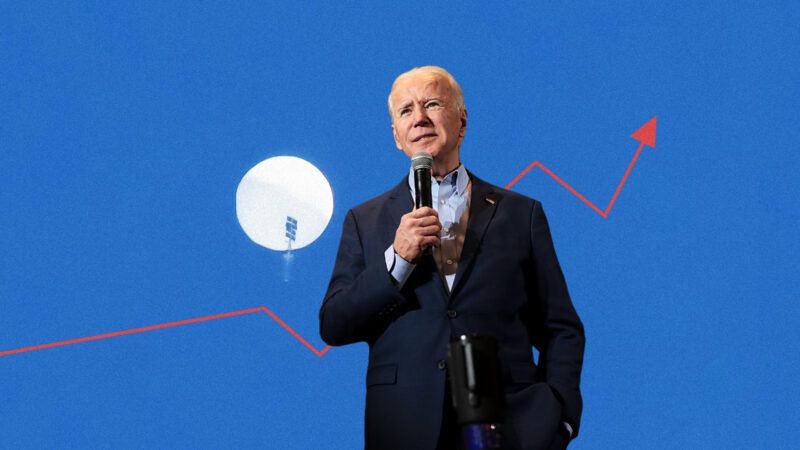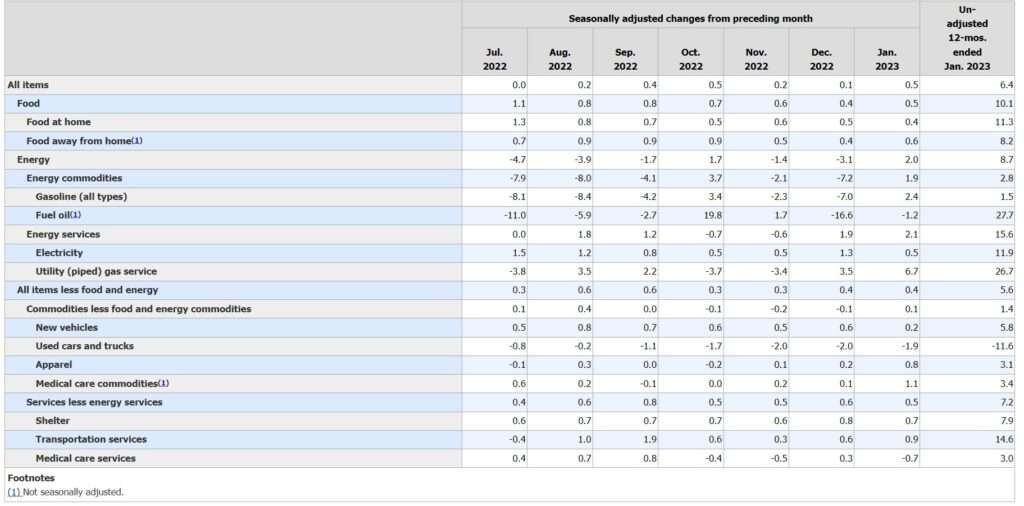Is Inflation Sneakily Starting To Rise Again?
January's consumer price data indicates another drop in annual inflation, but the past three months might tell a different story.

Consumer prices were 6.4 percent higher in January than they had been, on average, a year ago—the seventh straight month in which the annualized inflation rate declined after peaking at 9.1 percent in June.
Beneath the hopeful indicator in the topline figure, however, Tuesday's consumer price report gives off some worrying signals. Instead of continuing on a trajectory towards the Federal Reserve's target of 2 percent annually, inflation seems to be leveling off at a higher level and perhaps even starting to tick back in the other direction.
The annualized rate of 6.4 percent for January reported Tuesday by the Department of Labor is barely lower than the 6.5 percent rate posted in December. That's because prices rose by 0.5 percent during January, tying October for the largest month-to-month increase since inflation peaked in the first half of 2022. If you want to see prices truly fall—as opposed to merely rising less quickly, as the declining annualized rate shows—the month-over-month figures need to dip into negative territory. They are stubbornly refusing to do so.
January's increases were driven by energy costs (up 2 percent after declining in December) and ongoing increases in rent, which climbed another 0.7 percent after a 0.8 percent increase in December. Rent prices are up 7.9 percent over the past year, the largest increase ever.
Grocery prices continued their steady climb as well, jumping another 0.4 percent in January and up by 11.3 percent since this time last year. That's nearly double the overall inflation rate, and almost certainly contributes to the persistent feeling that high inflation isn't yet behind us.

Following last week's State of the Union address, where President Joe Biden declared victory over inflation, the White House is likely to spin the new economic figures as further evidence of that success. "Inflation continues to come down," tweeted Ronald Klain, the former White House chief of staff, on Tuesday morning.
The truth is a bit more complicated.
For starters, look at the so-called "core inflation," which filters out the more volatile categories including food and fuel prices. It actually increased to 0.4 percent in January from 0.3 percent in December.
Perhaps even more important is inflation in the "services" sector of the monthly consumer price index report. That's the category that Federal Reserve Chair Jerome Powell said two months ago would be the "most important" to tracking inflation at this stage of the fight, "because wages make up the largest cost in delivering these services."
In other words, inflation in 2021 and early 2022 was driven by rising prices for goods. But rising prices have spilled over into wages, which are harder to reduce than prices for goods. If a bushel of bananas is suddenly worth less than it would have been a few months ago, the price for bananas can more freely fall. Workers have contracts, unions, and laws that control how they are paid.
It's not surprising, but the transition from goods to services inflation is pretty much complete, with goods inflation now below 2%. From here on it's all about services and how sticky their prices prove to be. #CPIinflation pic.twitter.com/QapjVKWV8c
— John Authers (@johnauthers) February 14, 2023
Inflation in the "services" category rang in at 0.5 percent in January and has been persistently climbing throughout the past year.
Finally, even as wages continue to increase in an attempt to keep up with inflation, prices are still rising faster. Combining Tuesday's inflation data with last week's report on worker pay, CNBC concluded that average hourly earnings fell by 0.2 percent during January and are down 1.8 percent over the past year.
"I have a hard time seeing how the implied market breakeven of 2 percent inflation this year makes any sense," Jason Furman, a Harvard economist and former Obama administration economic adviser wrote on Twitter. "Absent a recession inflation below 3 percent is unlikely. And even with one inflation below 3 percent is far from guaranteed."
Inflation is still a major issue for any American who has to run a business or put food on the table, and the problem of rising prices might be getting more difficult to solve as wage inflation persists. A week later, Biden's celebratory declaration that "inflation is coming down" looks premature and out of touch.


Show Comments (52)